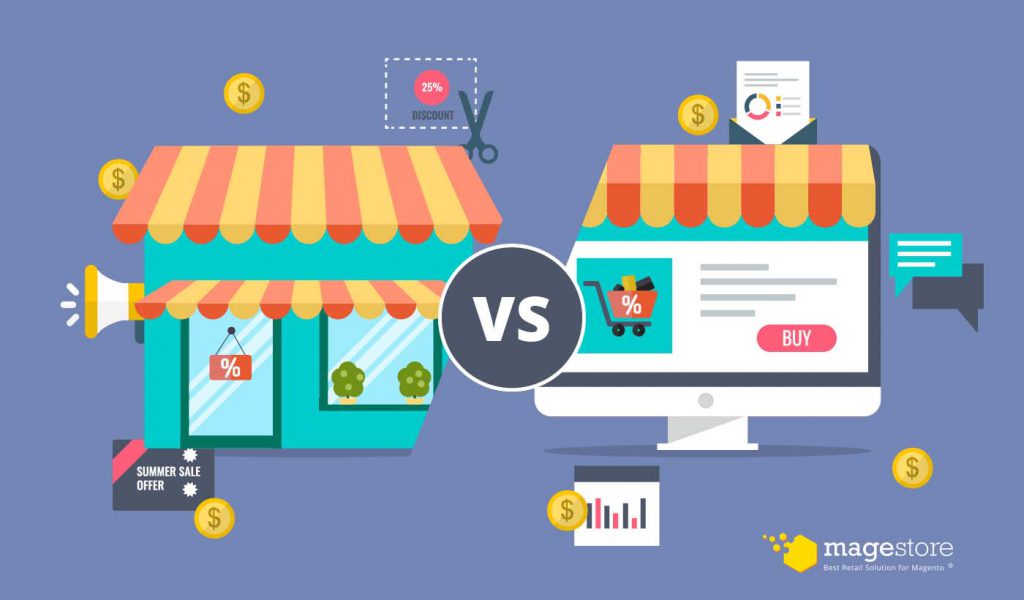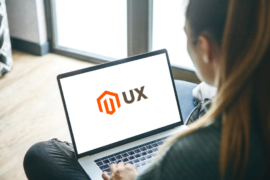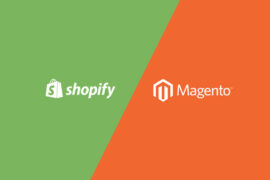Key retail players tend to go omnichannel. Walmart is entering the ecommerce arena with the purchase of online retailer Bonobos on the heels of the acquisition of online women’s apparel retailer ModCloth. At the same time, Amazon has acquired Whole Foods with 400+ local retail grocery stores.
Related post: Top 25 Omnichannel Retailer and What to learn from them
The smart approach to managing an omnichannel business requires an understanding of the specifics of the retail types. Just as ecommerce development differs from the launch of a brick-and-mortar store, they take different ways towards the market success. Marketing specialists should double their efforts to make both brick and mortar and online stores thrive. Ecommerce marketing strategies detailed in this article lose their effectiveness when applied to a brick-and-mortar store. Though the goals remain the same – promote a brand, attract customers and boost sales, some differences should be taken into account to develop rewarding marketing campaigns.
Location
The physical location is critical for a brick-and-mortar store. Even without marketing efforts, passers-by can come across it. Locations with more traffic usually have higher rates, so it is important to decide if the business will benefit enough to justify the cost.
Ecommerce marketing is the key to making an online store visible for visitors. Whether you employ SEO marketing to make it rank high in Google or promote the store via other digital marketing channels, you will see the result of your efforts in an increasing number of visitors.
Pricing
Even for similar products, brick-and-mortar and ecommerce pricing policies will differ. Retailers add a larger margin to goods in a brick-and-mortar store as more expenses need to be taken into account. For example, the cost of premises rent, staff salaries, etc.
Advertising means
Brick-and-mortar and online businesses benefit from different advertising resources. A brick-and-mortar store promotes its products or services where potential customers can stumble upon the advertisements. This involves leaflets, billboards, fliers in mailboxes, signs on the storefront, ads in catalogs, magazines, newspapers, television, and radio, etc. To attract more walk-in visitors, the following strategies can work out: giveaway events, in-store-only sales events, in-store contests.
E-shops with local delivery can also leverage traditional advertising means. Online ads in blogs, forums or other websites are more efficient for stores that deliver across the US.
Omnichannel Software
A Retail Management System streamlines separate sales channels to provide seamless shopping experiences anytime, anywhere.
Marketing cost
Advertising means define a large cost difference. The whole budget of a marketing campaign for an e-shop can be lower than one advertising channel of a brick-and-mortar store.
The price for a large billboard ranges from $1,500 to $30,000 per month depending on the location. A full-page ad in Washington post will cost you a small fortune – around $163,000. Milwaukee Journal Sentinel with the circulation four times less makes a similar offer for $23,000.
The eMarketing Sherpa eCommerce Benchmark Study granted by Magento found out that SEO and PPC (pay per click) combined make up much of the marketing budget (81%) of ecommerce companies with an average of $1 million in revenue. Larger businesses with $100 million average turnover and an established reputation halve the budget on SEO and PPC (39%). A robust marketing technique, SEO services vary between $350 and $2,000 per month depending on the scope of the project. The average cost per click in Google AdWords is between $1 and $2 on the search network.
Access to promotional information
Online environment offers the right of choice. The information is available 24/7, but a visitor chooses when to search for products, open an email or click a banner.
But imagine if you visit a supermarket regularly, and each time you are palmed on an advertising leaflet. Or you indicated the phone number in the survey conducted by a nearby brick-and-mortar store and start getting regular phone calls, often at an inconvenient time. You can’t control when to grasp the information and may get irritated. As a result, the promotion may have a reverse effect.
Target audience
Ecommerce marketing has a wider target audience coverage. It can reach an infinite audience and go worldwide. The aim of brick-and-mortar marketing is to drive visitors to specific physical locations.
Personalization
Ecommerce marketing creates more possibilities for a personal approach. Owners of online stores based on the Magento platform have access to the collection and analysis of customer data: demographic, interests, purchase and payment history, shopping behavior, preferred devices, etc. Make this information work for you. Apply customer segmentation and outcompete with targeted offers and personalized emails.
While launching a targeted ecommerce marketing campaign requires much effort, it’s nothing next to get this done for a brick-and-mortar store. If you want to improve customer in-store experience, you encounter a big difficulty – you need to identify a repeat customer. The custom software meeting your business idea like in this project of facial recognition can be a solution. The system provides available information about the customer and in-store staff can tailor the service accordingly. Mobile apps with 3D facial recognition can also be used for customer experience improvement.
Flexibility
Ecommerce analytics tools largely facilitate and speed up data collection and processing. By measuring traffic to your online store, monitoring traffic sources, social shares, conversion and sales rates among other KPIs, you get deep insights into how successful your marketing strategy is. This real-time tracking allows for its quick adaptation to improve the results.
Evaluating the performance of a marketing campaign for a brick-and-mortar store and promptly addressing changing conditions can be challenging. While measuring sales rates is easy, tracking what advertising means have attracted visitors requires some creativity. For example, you advertise your store via billboards and subway ads. If you offer a discount for those who say words ‘billboard’ or ‘subway’ at the cash desk, you can understand how rewarding each technique is. Still, as an advertising campaign usually has fixed contracts, you will not give it up instantly even if it doesn’t pay off.
Interactivity
Ecommerce marketing implies more interactivity for customers. They click banners, email links, comment in social networks. Brick-and-mortar marketing doesn’t create a dialogue. It leaves a message for customers to accept or reject.
Information about a product
The way products are presented in brick-and-mortar and online stores differ. The physical presence of products in a brick-and-mortar store implies that customers can get a true picture of what they are buying. If they need some additional information, they consult a salesperson.
Online stores offer virtual purchase of real products. Thus, ecommerce marketing specialists need to provide a full presentation of a product. Comprehensive information, detailed photos, videos (for example, apparel stores win more customers when they show how the clothes fit) can help a customer to choose. The interactivity of the online store is important for excellent customer service. Customers expect a quick response if they require more details. Add live chats and request forms to address customers’ issues promptly.
One marketing technique for different retail types. Will it work out?
When it comes to omni-channel in retail, let’s imagine that your business runs several brick-and-mortar stores and an ecommerce website with US-wide delivery. You want to promote your products using influencer marketing.
To assess the feasibility of the technique for brick-and-mortar stores, you need to analyze the influencer’s subscriber base. If the percentage of people living in the city where your stores are located is small, applying this strategy will not pay off. You’d better engage other ways to reach the target audience.
Influencer marketing works best for promoting an online store. The subscribers’ residence is not critical anymore. Having reached new audiences, you activate word of mouth marketing as well.
The ecommerce marketing campaign Crayola Canada developed last year is a stunning example of the efficiency of the technique for ecommerce. The company partnered with Viral Nation on 22 influencer posts and generated 4 million engagements and an influx of referral traffic.
Each marketing technique can bring considerable revenue or be an unsound investment. It is very important to resist the intention to employ all possible strategies, take time to research and assess possible results.
Brick-and-mortar vs. online business – a key to marketing success
A customer is a building block of retail. No matter how wide product assortment you have or how trained your staff is, your business doesn’t work well if you don’t have customers. By adopting the same approach to ecommerce and brick-and-mortar marketing, you risk failing in both. Marketing strategies should be developed with due regard to the business specifics. Leverage marketing advantages of different retail types and get the best results of your time, effort and investment.
Here’s also a brief author bio:
Igor Goltsov is a certified Magento developer. With 8+ years in Magento development and 13+ years in PHP development, Igor now applies his deep insights in ecommerce and expert skills at ScienceSoft. As a senior Magento developer, he contributes to complex projects involving the implementation of non-trivial platform’s features.
– Website: https://www.scnsoft.com/
– Social media accounts LinkedIn, Facebook, Twitter, YouTube.



![6 Best Shopify Shipping Rate Apps [2025] shopify shipping rate](https://blog.magestore.com/wp-content/uploads/2025/03/shopify-shipping-rate-270x180.png)
